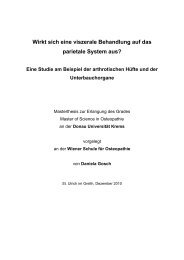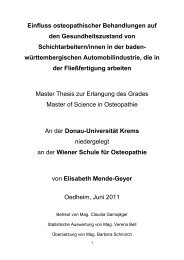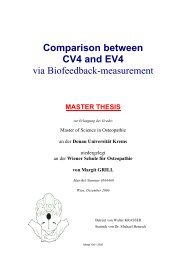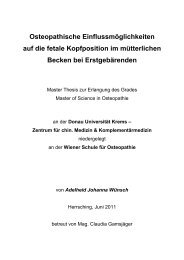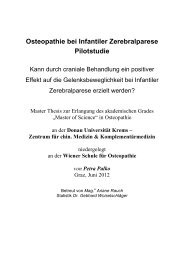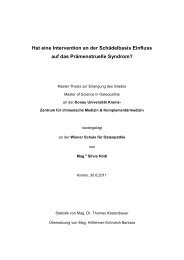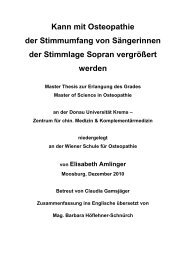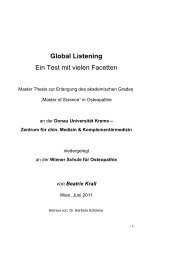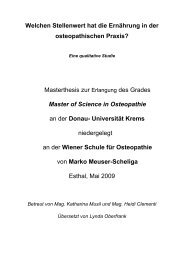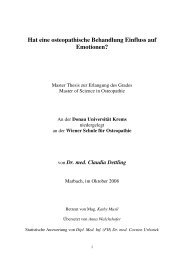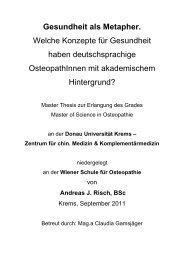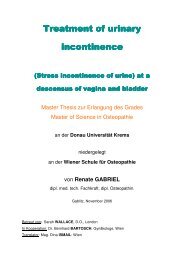2 Der viszeral assoziierte Schulterschmerz - Osteopathic Research
2 Der viszeral assoziierte Schulterschmerz - Osteopathic Research
2 Der viszeral assoziierte Schulterschmerz - Osteopathic Research
Sie wollen auch ein ePaper? Erhöhen Sie die Reichweite Ihrer Titel.
YUMPU macht aus Druck-PDFs automatisch weboptimierte ePaper, die Google liebt.
Viscerally Associated Shoulder Pain<br />
Subjective Perspectives and Diagnostic Procedures – the <strong>Osteopathic</strong> Point of View<br />
Viscerally Associated Shoulder Pain<br />
Subjective Perspectives and Diagnostic Procedures – the <strong>Osteopathic</strong> Point of<br />
View<br />
Shoulder pain has been reported to be a frequent motif of consultation of both<br />
therapists and doctors with a tendency to increase in industrial countries. According<br />
to the Austrian health survey 2006/2007, 6.2% (428.100) of the population indicated<br />
having had pain in the shoulders within the last 12 months, the prevalence increasing<br />
with age (Statistik Austria, 2007).<br />
The examination and evaluation of the shoulder and neck area count among the<br />
most demanding tasks for a therapist. A thorough structural diagnosis and evaluation<br />
of the possible causes is of utmost importance, the area connecting different parts of<br />
the spine and the extremities. Therefore, good clinical knowledge about the<br />
mechanisms involved in lesions of the shoulder area is an essential condition for the<br />
general understanding of shoulder pain and dysfunctions in the shoulder joint<br />
(cf. Diemer/Sutor 2010).<br />
Besides degenerative disorders of the shoulder joint itself, disorders affect the<br />
muscles, tendons and the bursa of the shoulder joint. These dysfunctions include the<br />
rupture of the rotator cuff, tendinitis calcarea, frozen shoulder and impingement<br />
syndrome (cf. Ehmer 2003). The impingement syndrome alone caused by a<br />
mechanical compression of the rotator cuff, the subacromial bursa and the long<br />
biceps tendon against the anterior surface of the acromion counts for 44 – 65% of all<br />
complaints in the shoulder area seen in a medical practice (cf. McClure et al. 2006).<br />
Among the risk factors for the onset of shoulder pathologies currently discussed are<br />
the narrowing of the subacromial gliding space, the shortening in the acromiohumeral<br />
distance during shoulder elevation, the abnormal position and movement of<br />
the scapula and the change in the correlation of the different muscles (cf. Hèbert et<br />
al. 2002; Gansen/Irlenbusch 2002).<br />
Since the problem-causing factor and the painful structure are located in different<br />
areas, a precise examination is often difficult but also highly relevant. If the reasons<br />
for the shoulder pain cannot be found, the treatment generally concentrates on the<br />
symptom, often resulting in an unsatisfactory treatment outcome. If the pain<br />
experienced by the patient cannot be reproduced by shoulder movements and tests,<br />
134 | S e i t e



